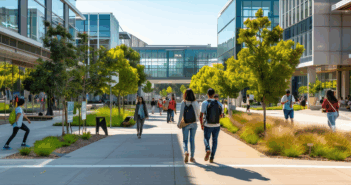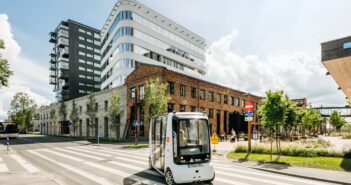This is a series of MIPIM Connect session reports from partner schools. In this post, University of San Diego reports on Implications of COVID-19 on the Office Sector. Watch this session below, and more in our MIPIM Connect playlist on YouTube!
According to Schoenert (left above), co-working was the last major shift in office design. His Paris based firm begin implementing it as recently as 5 years ago.
In part [co-working] is a tenancy business model, but on another it is a lifestyle shift – Schoenert
Co-working replaced traditional offices units in favor of denser, communal workstations, often accompanied by fitness spaces, drinks on tap, or other amenities. It embraced the idea of being a nomad, giving personnel the opportunity to work on their own schedule in locations all over the world. This type of working was fused into the new design codes and facilitated spontaneous collaboration, meeting, and even relaxation. Schoenert stated that wooden floors began to replace carpet to allow for easier cleaning, and that technical changes were made to accommodate the shrinking surface per workstation: more fresh air, water, electricity, emergency exits, and sanitary places.
Because co-working reflects a general lifestyle shift, larger companies began to embrace it. Previously, these employers would take an entire floor, utilizing a clean-cut, sturdy, and sterile design. Now they demand common areas and amenities like rooftop yoga, pet areas, and dry cleaners. A 25,000 m2 co-working project that Schoenert recently completed was 100% occupied within 3 to 6 months of completion. Economically, co-working providers have been having mixed success. High amenity providers, with more associated costs, like WeWork have been struggling. Lower cost, fewer amenity providers like bureau à parteger may be having more success.
Schoenert stated that co-working design guidelines have even transferred to co-living and mixed-use projects. He pointed to his 15,000 m2 co-living project featuring areas to eat, cook, work out, and commune together. He strives to make each part of the design distinct from the others, reinventing each area of the building to create a unique atmosphere in each space.
Sustainability is another major trend impacting design. For years, every project Schoenert has worked on has involved a green certification and now he sees a large demand for WELL certification. WELL is a green building label that certifies properties as having healthy characteristics for its users. These include better air quality, lighting, acoustics, and natural materials. Verschelde responded that an EHL University survey of its library renovation project produced an overwhelming response for plants and greenery to be included. He mentioned car manufacturers are even adding indoor plants to improve air quality and humidity in factories. Schoenert echoed this sentiment, indicating that all his urban projects with rooftops and terraces include plants and sometimes even vegetable gardens.
Schoenert explained that access to fresh air is immensely important to design and that even a small window can increase its occupants’ moods. Research shows that incorporating fresh air into a building scheme provides outsized benefits by reducing sick building syndrome and increasing occupant productivity. A 2017 study at Harvard University concluded that “occupants in high-performing, green-certified office environments scored 26 percent higher on tests of cognitive function, [and]had 30 percent fewer symptoms of sick building syndrome…” In summary, wellness-focused design produces more productive outcomes for those utilizing the space.
The design requirements post-Covid are much the same as those required before the pandemic – Schoenert
The co-working model allows for flexibility between office and home workspaces – a ubiquitous Covid trend. Because of the community areas, buildings require more frequent cleaning, hardwood floors, better flow of occupants, and faster outside air exchange. All these are trends bolstered by sustainability and wellness, and demanded in a post-Covid environment. According to Schoenert, the Covid-driven design demands are merely an extension of the last round of design code changes: co-working and mixed-use assets with a well-being focus. The new layer will be flexibility in the amount of time spent inside the buildings.



